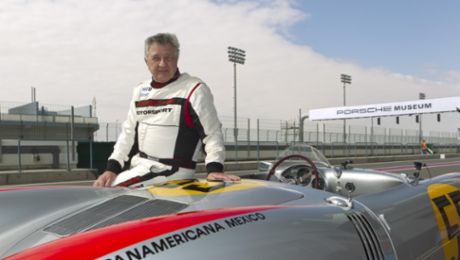Culture counts. This message is the guiding principle of UNESCO’s cultural programme. Every country has its own culture, which should be experienced holistically. At the same time, Porsche Heritage and Museum inherently passes on something of its own, namely driving culture as a cherished tradition. At the centre of the Porsche Heritage Experience is the transfer of knowledge and getting to know how the country lives its culture.
In the 75 Years of Porsche Sports Cars anniversary year, the event is taking place in the company’s own country, specifically in the state of Rhineland-Palatinate. Every two years, Porsche Heritage and Museum, and Porsche subsidiary companies, visit other cultures. In autumn 2023, participants in the third of these events can look forward to profound insights into the heritage- preservation work and cultural conservation in Germany.
Experiencing
Weinessiggut Doktorenhof
The first stop on our journey is at a traditional vinegar production plant in Venningen. The Doktorenhof has been in the Palatinate for generations. The predecessors of the current owners were vintners and agriculturalists. Then as now, it is important to the people running Weinessiggut Doktorenhof to pass on their knowledge to future generations. The Egyptians, Persians, Greeks, Romans and ancient Babylonians were making vinegar several thousand years ago. Vinegar is one of the most diverse foodstuffs, with a range of uses that could not be wider or more varied. It can be used for household cleaning, as a medicial remedy, as a cosmetic to beautify the skin, as a poultice or applied by hand to lower a fever. Essence of vinegar can be used to disinfect, flavour, remove stains, and reduce blood sugar and cholesterol. Since around 5000 BCE, vinegar has been an important preservative. As its base, it uses, for example, brandy, wine, grain and fruit juice. Participants can look forward to a guided tour of the cellar and the herb store, as well as a vinegar tasting session. There will also be anecdotes, history and all kinds of interesting information relating to vinegar, which has truly earned the prominent position it has enjoyed in food culture for millennia.
Remembering
Hambach Castle
The next cultural hotspot takes the Porsche Heritage Experience to the centre of the German wine route. Hambach Castle, situated between Lachen-Speyerdorf and Bad Dürkheim, is a symbol of the German democratic movement. On 27 May 1832, around 30,000 men and women celebrated what is known as the Hambacher Festival. They demanded freedom of opinion and the press, demonstrated for an end to censorship, and peacefully, but determinedly, voiced their support of a unified German nation. They waved a flag in the colours black, red and gold. Since this day almost 200 years ago, Hambach Castle has been seen as the cradle of German democracy. Awarded the European Heritage Label, the castle stands for the ideals and history of Europe. The initiative marks the birth of the fundamental rights on which all the constitutions of Europe were later based. To this day, the ideas and visions of this period of awakening are still being passed on to future generations through events and permanent exhibitions here.
Preserving
Speyer Cathedral
The story of our next destination goes all the way back to the Middle Ages. In around 1027, the Salian King ordered the construction of Speyer Cathedral to start. He dreamed of building the biggest church in the western world. In 1981, more than 900 years later, UNESCO added the building to its World Heritage list. The biggest Romanesque church in the world is not only a part of our cultural heritage, but is also a milestone in the history of Romanesque architecture itself. The ground plan of the basilica is characterised by symmetry and was a template for Romanesque building styles in the 11th and 12th centuries. The harmoniously positioned towers frame the structure formed by the nave and the transept. The east and west sections of the building are also finely balanced. Speyer Cathedral was damaged by fire many times in the course of its long history, most grievously in 1689. Its reconstruction was begun almost 100 years later. For most of the past centuries, and even to this day, the building has undergone restoration and repair work. As in the Porsche Heritage and Museum department, this work is exclusively about preserving valuable cultural assets for future generations. Ultimately, both the cars in the collection and the thousand-year-old building are contemporary witnesses that tell a story. As they take a look behind the scenes, the participants gain an insight into the building conservation measures and the special restoration methods used at Speyer Cathedral and by Porsche.
In order to preserve, maintain and pass on our traditions, the museum is continually staging new exhibitions. The Porsche AG company archive houses 2 kilometres of files, 2.5 million photos and slides, 4,000 books, and 1,700 hours of film material. This is not so that it stays in dark reading rooms, but so that all the information about the brand can be shared with people from all over the world.
Exploring
Hornbach Abbey
In 2000, Christiane and Edelbert Lösch made their dream of an extraordinary hotel come true. Over the past two and a half years, they have had the rooms and suites of the Kloster Hornbach Hotel renovated and refurbished, with the focus of the architectural redesign always on tradition and sustainability. The goal was to preserve the old qualities of the hotel and enrich them with new ones. This is how the historical cloister came to be enclosed in a state-of-the-art foyer and reception. Everywhere that the mystical atmosphere of this holy place can be felt and its story is told, the family owners have focused on conserving it for future generations. The culturally and historically significant architectural monument in the southwest of Rhineland-Palatinate was originally built among the ruins of a Benedictine abbey from the eighth century. Between the main building and the former left side aisle of the abbey basilica, an intermediate building was erected that has been home to the Historama museum since 2002.
This exceptional hotel will also be the home of the Porsche Heritage Experience team, with the small abbey town acting as a kind of control centre. We will be starting our day trips from here and convening in the hotel again in the evenings. We’ll visit ancient walls that are still standing many centuries later, walk through the garden and see culinary and medicinal herbs in the ground, and on our plates in the evening, and enjoy presentations from the Porsche Heritage and Museum department – all in an ancient abbey with a state-of-the-art atmosphere …
Investigating
Hut culture
In the Palatinate Forest and its surrounding regions there are 14 hiking homes, 60 rest houses and ten examples of what are known as hiker huts. Most of these are operated and maintained voluntarily by members of local groups. The hiker hut culture has been an intangible cultural heritage asset protected by UNESCO since 2021. “We are very proud of this award,” says Florian Bilic, Managing Director of the Pfälzerwald-Verein e. V. “This distinction is a great recognition of our voluntary helpers and will spread awareness of our culture among people who haven’t had the opportunity to experience it yet.” In the Palatinate Forest huts, hikers are introduced to the cuisine of the region – for example, stuffed pig’s stomach and a classic spritzer in the region’s traditional ‘Dubbe’ glass. “After a beautiful hike there’s nothing better than good food and good company in one of the huts. Everyone gets talking and one experiences a feeling of being at home here,” the 29-year-old explains. Visitors can also learn about the local flora and fauna in the Palatinate huts, and the unique features of their surroundings. In this way, around 500 to 1,000 volunteers pass on their traditions and customs to future generations and share their valuable experiences. “Some of our huts also offer rustic overnight accommodation at a budget rate. Sleeping in the forest and planning the rest of one’s trip from there is of course very charming,” Bilic confides.

